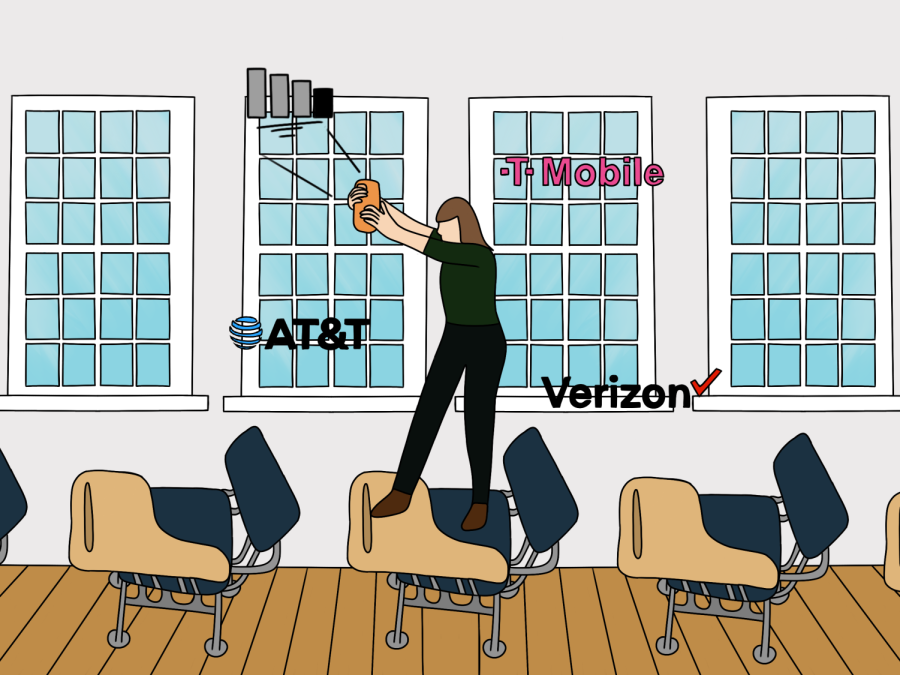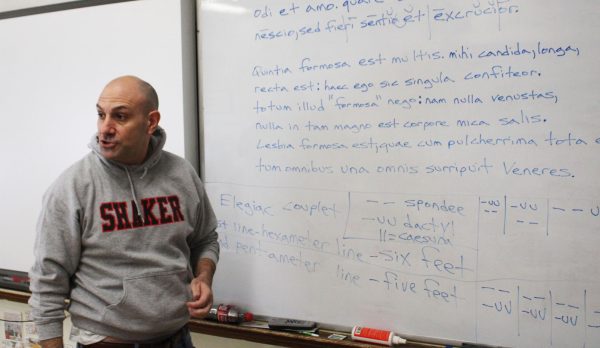Students Agree: Using Phones Here is Hard
More than 500 students say cell reception is poor or nonexistent at SHHS
Nearly 95 percent of Shaker Heights High School students surveyed reported experiencing trouble with cell phone reception in the building.
According to the Federal Communications Commission, cell reception works by communicating via radio waves; calls are connected by using a system of base stations. The quality of cell reception can be affected by factors including distance from cell towers, obstacles such as buildings and trees, and network capacity – the number of people trying to use cell service in an area.
According to the FCC, large, brick buildings such as the high school have poor cell service because the radio waves have a harder time penetrating the layers of brick, stone and plaster. Additionally, on the average school day, more than 1,500 people are in the building and trying to connect to cell towers, further diminishing connection quality.
“Shaker buildings are, as most know, ‘seasoned,’ and were built during an era when something like ubiquitous and instantaneous access to cellular phones (or maybe even phones in general for that matter) would have been thought of as tantamount to flying cars or time travel. They are essentially fortresses built in a manner and with materials that often degrade and, at worst, completely block carrier cell signals,” John Rizzo, executive director of technology and media services, wrote in an email.
A survey offered to students during Crew Nov. 15 drew 552 respondents. According to the responses, the consensus among students is that reception is best on the third floor. Students identified the basement and small auditorium as the worst areas for service. This is likely because there are fewer obstacles to the signal on the third floor, while the basement exists below three levels of stone floors and brick walls.
Some students wrote that even when their phones indicate three bars of service, they still cannot send a text message. According to Wilson Amplifiers, a company that develops reception boosting technology, this contradiction exists because it’s up to carriers to decide what a bar of reception means; one carrier’s single bar of reception could be equivalent to two bars for a different carrier.
Some students noted that concerns about service are not always about entertainment or socializing. “I hope teachers understand that getting reception isn’t all about playing on our phones. In multiple scenarios I have been stuck without any way to contact my family members. I have been stuck at school trying to contact for rides home,” one survey respondent wrote.
In such instances, students can use any classroom phone by dialing 8 and then the phone number they need to reach.
Students also mentioned that they sometimes need to use their phones to submit assignments, such as when taking a picture of work and turning it in on Google Classroom. Poor reception can make this impossible.
Some students wrote that their cell phone reception is worse this year than in years past. Rizzo explained that the decline is due to service providers. “As cellular networks are upgraded, the IT department (and others inside and outside of the district) have noticed a substantial degradation of cell reception not only within Shaker buildings but throughout the city and beyond,” he wrote.
Some students responded with a misconception that the district interferes with reception. “The school blocks cell connection to try to get students off their phones which is so dumb,” wrote one respondent. This is incorrect; blockers of this type are illegal. “Shaker IT does not have any control over [declining reception in buildings],” Rizzo wrote.
Students have all been issued school Chromebooks to complete work, and this policy has been cited as the reason for discontinuing student access to school Wi-Fi networks. The only solution other than student Wi-Fi access, which would enable cell phone use, is “to install carrier-agnostic, in-building cell service amplification systems in each building,” Rizzo wrote. These systems work by attaching antennas to the outside of the building, then placing antennas inside the building to amplify and distribute the signal. This type of system can cost $5-10 per square foot, and the high school campus is 324,956 square feet. Installing such a system could cost between $1.6 million and $3.25 million.
The survey indicates that poor reception inconveniences everyone in the building at a time when life without phones and service is unimaginable for students. One teacher who responded to the survey, however, wrote, “There should be phone reception blockers in the building. Students don’t need cell phones in school. Generations of humans did without them and turned out just fine.”
Comment using your Facebook, Yahoo, AOL or Hotmail account










